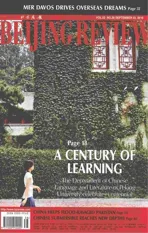The World’s Top Choice
2010-09-12ByDINGWENLEI
By DING WENLEI
The World’s Top Choice
By DING WENLEI
China remains the most popular destination for foreign direct investment
China maintained it’s top seat as the most attractive destination for global foreign direct investment (FDI), said a report by the United Nations Conference on Trade and Development (UNCTAD)—and it is likely to remain so for the next two years.
The report, World Investment Prospects Survey 2010-2012 (WIPS), based on interviews with 236 international companies and 116 investment promotion agencies, was released at the 2010 UNCTAD World Investment Forum in Xiamen, Fujian Province on September 7, 2010.
Thanks to three decades of attracting FDI and sticking to the reform and opening-up policy, China has been the top FDI destination worldwide for several years, according to UNCTAD’s reports. China absorbed $90 billion in FDI and approved 23,435 foreigninvested companies in 2009, making it the second largest FDI recipient after the United States.
More than 470 of the top 500 multinational companies have established their presence in China. By July this year, China had received $1.05 trillion in FDI, ranking frst among developing countries for 18 years in a row, said Premier Wen Jiabao at the opening ceremony of the Annual Meeting of the New Champions 2010, held in Tianjin on September 13.
“China is leading the FDI recovery. As such, the nation’s FDI growth has outpaced other countries,” said James Zhan, Director of the Division on Investment and Enterprises under UNCTAD.
In 2009 when global FDI declined 39 percent, China’s FDI only fell by 2.6 percent. And China soon regained momentum. For the frst eight months of this year, China attracted a total of $65.96 billion in FDI, rising 18.06 percent, and 16,721 foreign-invested enterprises had been approved, up 18.33 percent, according to statistics from the Ministry of Commerce (MOFCOM).
“China’s FDI this year is expected to exceed $100 billion, up 11 percent from the previous year,” said Chinese Minister of Commerce Chen Deming.
Expansion
China’s FDI history is often divided into three periods: the first period (1979-1991) with annual FDI volume at around $2 billion-$3 billion, the second period (1992-2001) with annual FDI exceeding $40 billion, and the third period (2002- present) with annual FDI surpassing $80 billion.
During the early years after China adopted its reform and opening up policy in 1978, only a few world-renowned multinationals, such as AIG, Coca-Cola, Siemens and Sanyo, opened offices or established joint ventures in China. It was not until 1984 that FDI began increasing rapidly.
FDI volume totaled $25.1 billion between 1979 and 1991, according to MOFCOM statistics.
The year 1992 marked major shifts in both the China strategy of attracting foreign investment and multinationals’ investment strategies in China, said Wang Zhile, a researcher on multinational corporations, in his report on multinationals and China’s threedecade reform and opening up.
China seized the opportunities when multinationals relocated their factories worldwide, thanks to China’s decision to establish a socialist market economy in 1992, said Wang.

A HOUSEHOLD NAME: McDonald’s is a household name now in China, thanks to its successful localization efforts
After 1992, trailblazer multinationals began to expand their investments in Chinaand many countries’ top 20 industrial companies set up factories in China, investing in more and bigger projects. During the second period (1992-2001), China attracted $370.2 billion FDI in total.
China’s entry into the WTO in 2001 marked a milestone in China’s reform and opening up, and also turned a new page for FDI in China, said Wang in the report. Paidin FDI in China stood at about $561.75 billion from 2002 to 2009, according to MOFCOM statistics.
Diversity
In the past decade, multinationals increased and diversifed their investments in China, investing in R&D, product design, and services such as logistics, marketing, wholesale and retail trade, banking and insurance, according to Wang’s report. They also invested in fundamental industries such as core raw materials and parts for their productions in China.
By the end of 2007, multinational companies had established more than 1,200 R&D centers, mainly in Beijing, Shanghai, Tianjin, Jiangsu and Guangdong. The R&D technical service sector attracted FDI of $917 million in 2007, up from $57 million in 2000, said MOFCOM statistics.
“Large multinationals, especially Fortune 500 companies, have been establishing more or upgrading their R&D in China into global R&D centers in recent years,” said Du Debin, dean of city and regional economics with Shanghai-based East China Normal University in a China Business News report.
Multinationals’ investments in their China R&D centers had increased 33.3 percent annually between 2004 and 2006, Du said, citing MOFCOM statistics from a survey on 75 multinationals.
From 1997 to July 2010, FDI in China’s service sector stood at $267.9 billion, accounting for 32.4 percent of the total amount, according to MOFCOM statistics.
In recent years, foreign investors also went on an acquisition spree for Chinese companies. A total of 863 cases of mergers and acquisitions (M&As) were approved in 2009, up 1.9 percent year on year, accounting for 3.6 percent of newly approved foreign companies. Of them, 555 cases, or 64.3 percent, took place in the service sector, up 17 percent from a year earlier.
Contributions
Over the past three decades, multinational companies have become deeply interwoven into China’s economy and provided enormous momentum for its fast growth.
By the end of 2009, the Chinese Government had approved the establishment of 683,000 foreign-invested enterprises, said Zhang Xiaoqiang, Vice Chairman of the National Development and Reform Commission.

NEW HOME: BlueScope Steel, the leading steel company in Australia and New Zealand, has set up a factory in Suzhou Industrial Park, JiangsuProvince. The park is home to over 3,000 foreign-invested enterprises
In 2009, foreign-invested enterprises provided 45 million jobs. Their industrial output accounted for 28 percent of the country’s total, and taxes paid were about 22.7 percent of the country’s total tax revenue that year, said Zhang. Foreign-invested enterprises are also China’s major exporters and their exports accounted for 55.9 percent of the country’s total in 2009.
In addition, multinationals have introduced modern industrial products and technologies into China and encouraged, through their examples, Chinese companies to restructure and practice modern corporate governance, said Wang.
Also, they helped cultivate a number of industries and accelerate China’s industrialization process through technology transfers, and encouraged restructuring within the country’s industrial sector through frequent cross-border M&As.
M&A will become a dominant investing strategy for multinationals in China. Thanks to these M&A activities, China’s industries will grow bigger and more competitive, said Wang.
Multinationals also contributed to closer economic ties between China and their home countries, and easy access for China to international resources.
But they still face a number of challenges. While some multinationals have yet to fnd win-win solutions for themselves and China, others need to shoulder more social responsibilities, Wang said.

